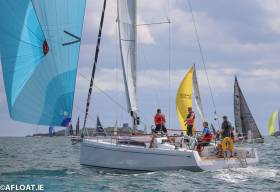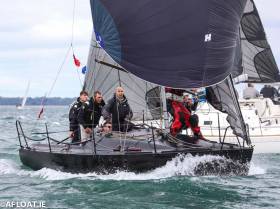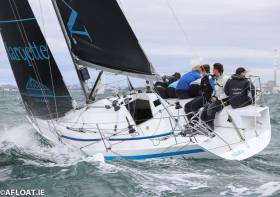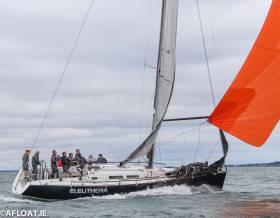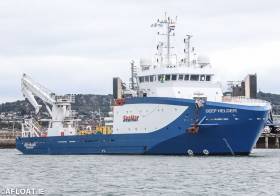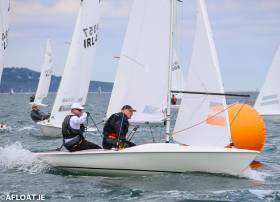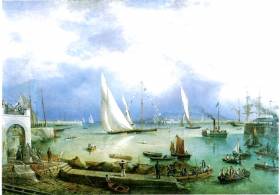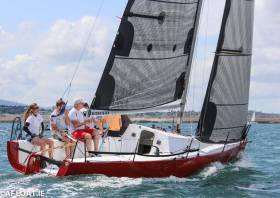Displaying items by tag: Dun Laoghaire Regatta
They gave the offshore wannabes a real run for their money today in the Coastal Race of Volvo Dun Laoghaire Regatta, yet there was still a certain sameness about the final results, as Seamus Fitzpatrick’s attractive First 50 Mermaid IV was first again while George Sisk’s Xp 44 WOW was third again, but in between them this time was the little J/109 Mojito (Peter Dunlop & Vicky Cox, Pwllheli & Royal Dee), though overall it’s Mermaid first, WOW second, and Paul O’Higgins’ JPK 1080 Rockabill VI third in Div A, while Div B is led by Mojito with another J/109, Nigel Ingrams’ Jet Stream from Holyhead, in second, and the veteran Mills 36 Raptor (Denis Hewitt RIYC & all the usual suspects) at third.
Just in case you hadn’t noticed, it’s the glorious Twelfth of July through all classes, and northern boats at VDLR 19 have been celebrating with particular style in Class 3, where Rory Fekkes' souped-up Beneteau First 8 from Carrickfergus was in top form to take a couple of firsts while discarding a 2nd, putting him on a very competitive 3pts overall against the 7 points of Howth’s Ger O’Sullivan with the Formula 28 Animal, while in third slot is another northerner, Charlie McAllister from Antrim Boat Club on Lough Neagh with the Quarter Tonner Fait Accompli - a year ago, Charlie was very much involved in organising the International Atlantic Challenge for a fleet of Bantry Boats from both sides of the Atlantic on Lough Neagh, now it’s his turn to be on the podium on his own account.
 Brendan Foley's highly optimised Impala, Running Wild from the Royal St George Yacht Club
Brendan Foley's highly optimised Impala, Running Wild from the Royal St George Yacht Club
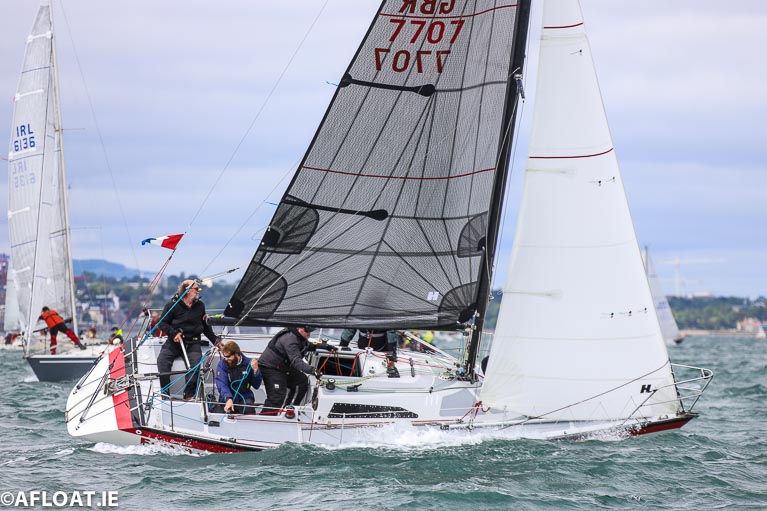 Charlie McAllister from Antrim Boat Club with the Quarter Tonner, Fait Accompli
Charlie McAllister from Antrim Boat Club with the Quarter Tonner, Fait Accompli
Class Four
Jonathan Fawcett’s S&S Classic She 31 She Too from Abersoch found things very much to her liking, she’s first overall after a couple of firsts today while the DMYC Trapper 300 Eleint (Michael Matulka) stayed in touch with a couple of seconds, third place going to the Frazer Meredith syndicate with the Sonata Asterix
Nigel Biggs was in top form among the Half Tonners to register 2,4, 1 with Checkmate XVIII, while Ronan and John Downing from Royal Cork were feeling their journey was very well worthwhile through now lying second overall with Miss Whiplash, with Colin and Cathy Kavanagh from Howth with the J/97 The Jeneral Lee finding that 4th and 3rd with a discarded 10th had them moving into third overall ahead of some very fancied boats in a class where the competition is razor sharp – overnight leader Mata (Wright brothers) is now back in 6th.
 A Class Two start with (red hulled) Antix Beag the weather boat
A Class Two start with (red hulled) Antix Beag the weather boat
 Harmony
Harmony
 Checkmate XV
Checkmate XV
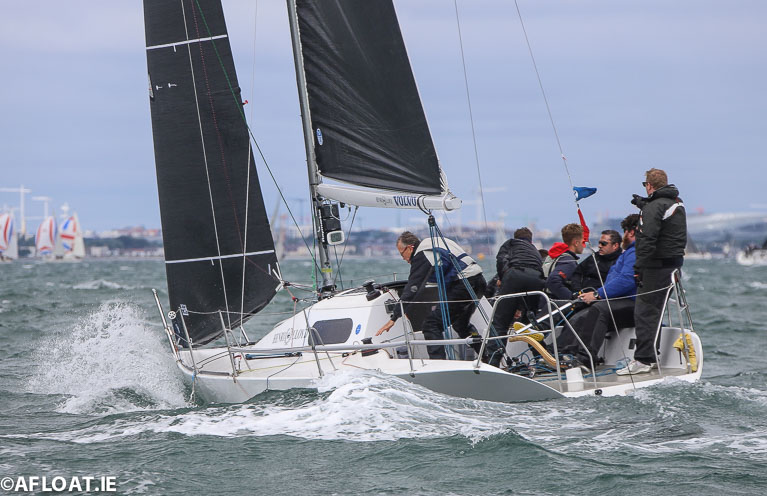 Miss Whiplash
Miss Whiplash
With a gently rising barometer and a nor’west breeze coming out of a soft grey sky (fifty shades and counting), most folk expected that the wind would fade on Day 2 of the Volvo Dun Laoghaire Regatta 2019 writes W M Nixon. But on the contrary, the breeze became decidedly brisk to push up to 20 knots here and there, with some boats providing entertainment with the old “She’d turn round and look at you” routine, making for a very welcome change after yesterday afternoon’s crawlathon.
In Class One, Class 1 there are J/109s in profusion, and Richard Colwell and Johnny Murphy – with Mark Mansfield on the strength – were in sparkling form on Outrajeous. After yesterday’s single 9th place, they logged two firsts and a third today, putting them one point overall ahead of Tim and Richard Goodbody with White Mischief, while the J/109 parade continued with John Maybury’s Joker getting third, sixth and fourth after being overnight leader to lie in third, close ahead of Pat Kelly’s Storm.
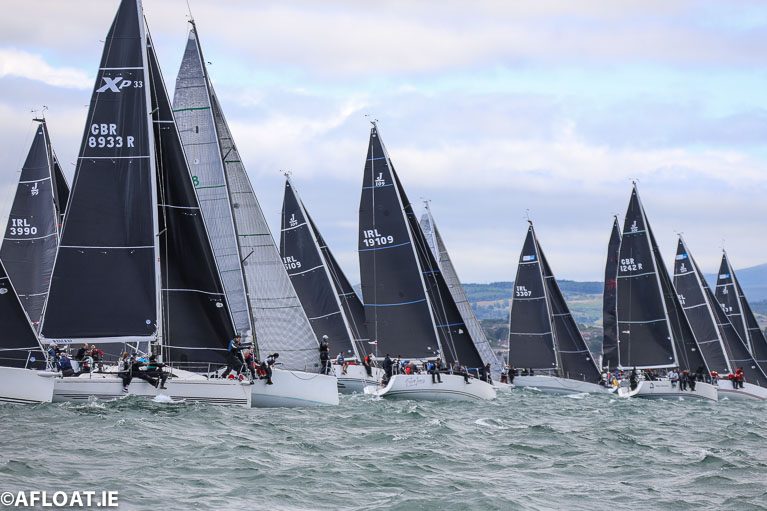 A fantastic turnout in Class One. Overall leader 'Outrajeous' (IRL 19109) prepares to start in the middle of the line to take advantage of Dublin Bay's shifting northwesterly
A fantastic turnout in Class One. Overall leader 'Outrajeous' (IRL 19109) prepares to start in the middle of the line to take advantage of Dublin Bay's shifting northwesterly
 Tim and Richard Goodbody's J109 White Mischief
Tim and Richard Goodbody's J109 White Mischief
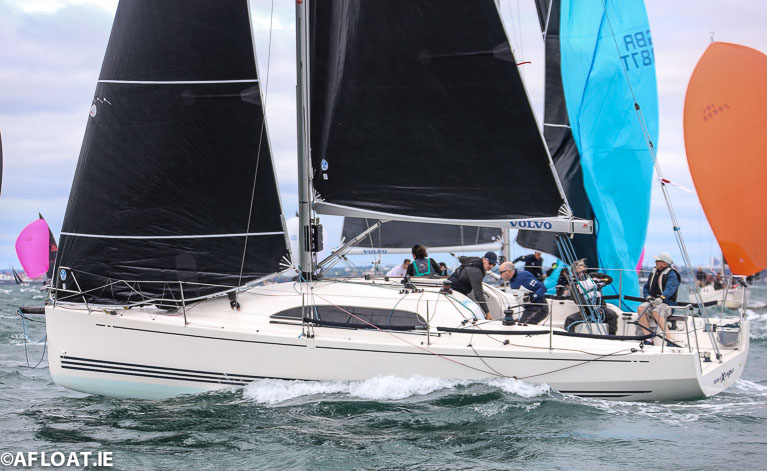 The XP33 Bon Exemple (Colin Byrne) is back on the water after mast repairs this month
The XP33 Bon Exemple (Colin Byrne) is back on the water after mast repairs this month

 At the Leeward mark ...
At the Leeward mark ...
 Defending champions, Joker II
Defending champions, Joker II
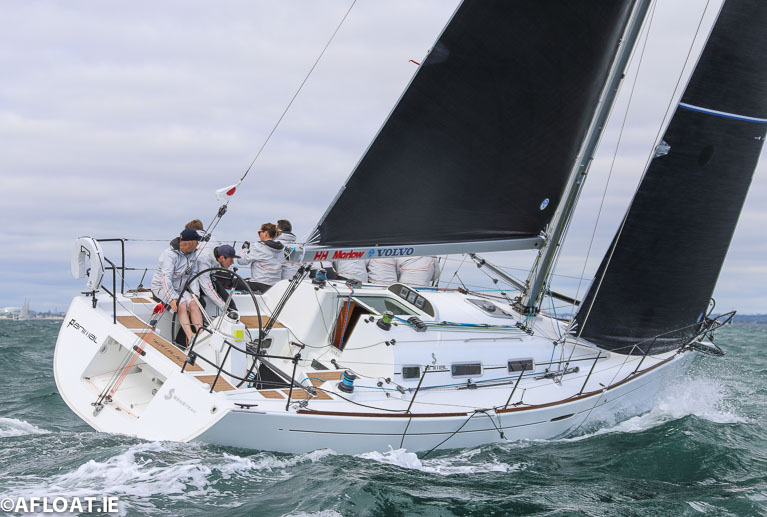 RC35 Champion Animal
RC35 Champion Animal
 Outrajeous takes the win at the finish line of race three
Outrajeous takes the win at the finish line of race three
Greystones Grand Soleil 'Eleuthera' Stays Leader of Class Zero at Volvo Dun Laoghaire Regatta
Frank Whelan’s Grand Soleil 44 Eleuthera from Greystones is making hay among the biggies in the second day of Volvo Dun Laoghaire Regatta, helped no doubt by the presence on board of sailmaker Shane Hughes, and they had 2,1,2 today with a Twelfth of July celebrating northerner, Jay Colvillle with the First 40 Forty Licks (East Down YC), enjoying the stronger breeze to log 3,2, 1 while Jamie McWilliam stayed in third overall in Signal 8 from Hong Kong, but with a descending scoreline of 1,4,6 – the latter now becoming his first discard.
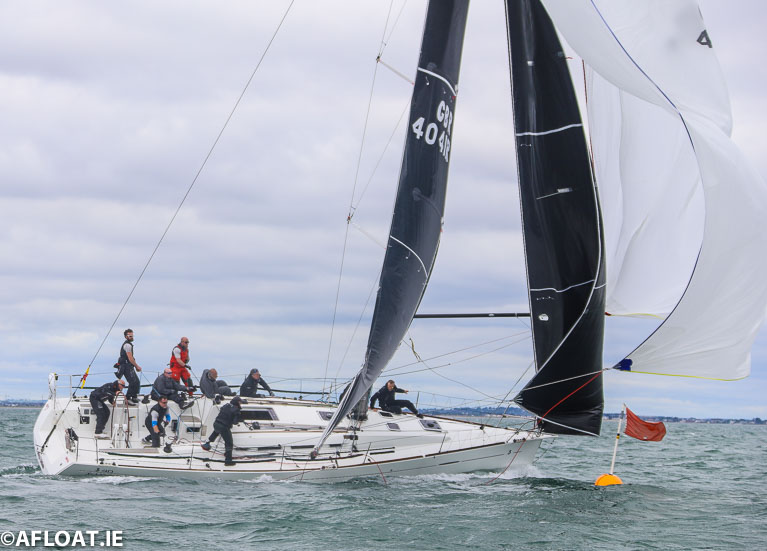 Jay Colville's First 40, Forty Licks is second overall
Jay Colville's First 40, Forty Licks is second overall
 Jamie McWilliam stays in third overall in Signal 8 from Hong Kong
Jamie McWilliam stays in third overall in Signal 8 from Hong Kong
 El Gran Senor deals with gusty north westerlies on Dublin Bay
El Gran Senor deals with gusty north westerlies on Dublin Bay
Frank Heath's local entry Crazy Horse of the Royal Irish YC and Royal St George YC leads the Dublin Bay challenge to overcome the leading visitors in the Beneteau 31.7 scratch fleet at Volvo Dun Laoghaire Regatta.
Heath is only two points off the overall lead in the 14-boat one-design fleet but, as Afloat reported here, overnight leader John Minnis's Royal Ulster Yacht Club entry, Final Call, has stayed on top of the leaderboard today after four races sailed with one discard.
The Ulsterman leads Jason & Debbie Corlett's Isle Of Man Yacht Club entry, Eauvation by a single point with Heath a point off the Corletts.
Racing continues tomorrow.
So keen were Volvo Dun Laoghaire Regatta organisers to attract the historic Howth 17s across the Bay to Ireland's biggest sailing event today that when the 65-metre 'Deep Helder' moved into er, a prominent position in the leisure harbour it so resembled a regatta finish line position off the Royal St. George YC that some local wags reckoned VDLR had pulled out all the stops for the travelling HYC contingent.
But, as regular Afloat readers will know, the impressive vessel is in fact involved in planned cable survey works on the EirGrid East West Interconnector During the survey. The vessel deployed underwater survey equipment along a thin 50m corridor.
Deep Helder is equipped with an offshore crane, survey and ROV systems (quite a bit more kit than your average Committee Boat)
After five races sailed at the Volvo Dun Laoghaire Regatta, Flying Fifteen National Champions David Gorman and Chris Doorly clearly broke the overnight points tie in their favour today when they won all three races to stamp their authority on the 24-boat fleet.
The National Yacht Club duo now lead the regatta by a cool 10-point margin at the halfway stage.
Second overall is the Dun Laoghaire Motor Yacht Club's Ben Mulligan sailing with Cormac Bradley. Third is Fflagella, Tom Murphy and Carel La Roux also of the National Yacht Club.
Racing continues tomorrow.
 Ben Mulligan and Cormac Bradley are second overall
Ben Mulligan and Cormac Bradley are second overall
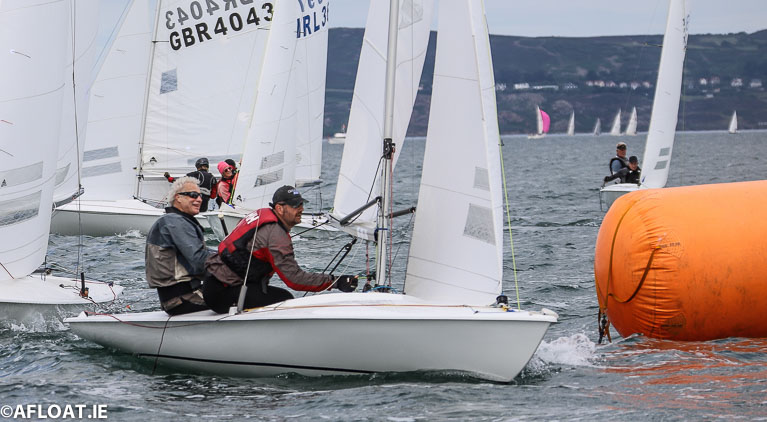 Tom Murphy and Carel La Roux are third
Tom Murphy and Carel La Roux are third
When the Earl of Kildare - subsequently the Duke of Leinster – commissioned the building of his fine new townhouse in 1745 in what was then the unfashionable south side of Dublin, he can scarcely have imagined that nearly three centuries later, the building and its name would be synonymous with the exercise of democratic government in Ireland, based moreover on the notion – probably totally inconceivable at the time - of universal suffrage writes W M Nixon.
The current role of Leinster House is a classic case of an unintended consequence and one which is largely beneficial. Democracy seems a more natural way of government when its beating heart is in a building which is comfortably located as an integral and elegant yet not-too-grand part of the fabric of the centre of the capital city.
The contemporary configuration and role of Dun Laoghaire Harbour is another interesting unintended consequence. Half a century after Leinster House was built, a maritime movement was getting underway for another major building project – a public one this time - which eventually had several results, the main one being the construction of Dun Laoghaire Harbour in the unchanged overall shape we still know today.
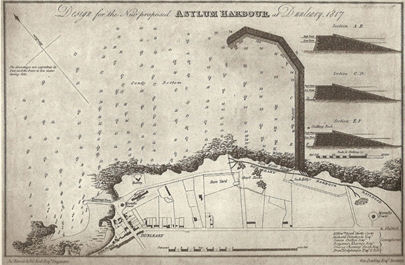 The original suggestion was for one breakwater almost a mile to the east of the little fishing port of Dunleary
The original suggestion was for one breakwater almost a mile to the east of the little fishing port of Dunleary
 The idea develops, and the title of “Asylum Harbour” goes public
The idea develops, and the title of “Asylum Harbour” goes public
The increasing loss of life in shipwrecks which resulted from onshore gales in Dublin Bay as vessels tried to enter or leave the shallow port of Dublin led to a growing body of opinion in favour of the construction of a substantial asylum anchorage immediately east of the little creek of Dunleary. The basic requirements were very basic indeed. The initial idea was that there would be just one enormous breakwater pointing approximately northeastward, and then curving northwest at its outer end. The thinking was that in heavy onshore weather, ships could anchor in some safety in its lee until conditions improved.
It couldn’t have been simpler, for there was no mention of any shoreside infrastructure to go with it. The idea was that it would only be used by ships in severe conditions and for the shortest possible period. But by the time the construction was underway in 1817, it seemed more sensible to include a West Pier to make it more of an enclosed harbour, and after a Royal visit in 1821, little old Dunleary – still only a fishing village of limited facilities – had become Kingstown, and the massive new port of refuge became known as The Royal Harbour.
 The first regatta at Kingston was staged in 1828
The first regatta at Kingston was staged in 1828
The originators of the project had thought only of providing temporary shelter for merchant and military ships in the most basic possible facility. But other minds and interests saw it in different ways. By 1828 the first regatta had been staged, and at the same time, the first steam and sail-driven ferry boats were running an unofficial occasional cross-channel service from Kingstown to Holyhead and the River Dee.
 The authorities were eventually persuaded to include Dunleary within the new harbour, but essentially it meant the end of an ancient coastal community living around its own creek
The authorities were eventually persuaded to include Dunleary within the new harbour, but essentially it meant the end of an ancient coastal community living around its own creek The “Game-Changer” – the opening of the Dublin-Kingstown Railway in 1834 was the real beginning of the harbour town’s progression towards becoming a fashionable residential area and a ferry port.
The “Game-Changer” – the opening of the Dublin-Kingstown Railway in 1834 was the real beginning of the harbour town’s progression towards becoming a fashionable residential area and a ferry port.
Then in 1834 the pioneering Dublin to Kingstown railway opened for business. This was the real game-changer in the history of Dun Laoghaire Harbour, which is a long litany of unintended consequences. The railway provided rapid accessibility which led to fashionable if notoriously uncoordinated shoreside residential developments, and the recreational use increased with waterfront yacht clubs. Then as the railway network increased all over Ireland, special boat trains were able to deliver people direct to cross-channel ferries berthed on either side of the new Carlisle Pier.
It was all on a modest scale as the ships were still relatively small, yet by this stage, we were a long way from the original Asylum Harbour concept, as the entrance to Dublin Port had been substantially dredged and steam had taken over as the main motive power for ships.
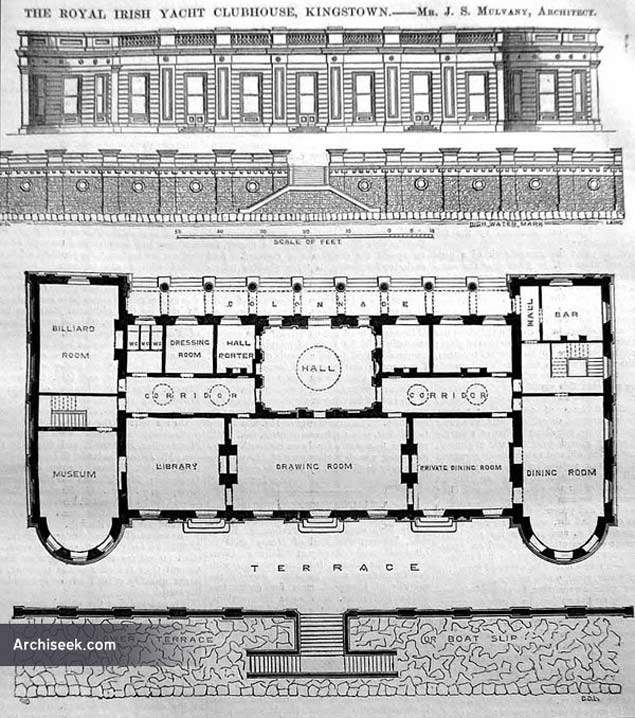 Shoreside recreational facilities developed in tandem with the harbour’s increasing popularity – the plans for the Royal Irish Yacht Club by John Skipton Mulvany. Opened in 1850, it is the world’s oldest complete purpose-designed yacht club building
Shoreside recreational facilities developed in tandem with the harbour’s increasing popularity – the plans for the Royal Irish Yacht Club by John Skipton Mulvany. Opened in 1850, it is the world’s oldest complete purpose-designed yacht club building
 The Royal Irish Yacht Club today
The Royal Irish Yacht Club today
There was a sort of golden era when ships of the Royal Navy were still small enough to find Dun Laoghaire a convenient port which was secure from shoreside troubles, such that it is said that a crew change from a naval ship temporarily in Kingstown could be effectively arranged by putting the entire ship’s complement on a closed train which would then travel unhindered across Ireland to the main naval base at Cobh without the public being any the wiser, for these could be restless times.
As long as the main means of access to the ships was by train, Dun Laoghaire worked very well as a ferry port which – thanks to the modest size of the ships – was minimally intrusive both to other harbour users and to those who lived by the harbour.
But the next transport change, trying to deal with Ro-Ro vehicles arriving by road, was much more problematic. For sure, things could be done on the waterfront in the harbour to accommodate Ro-Ro ships without excessive intrusion. But even this apparently simple challenge proved too much during the 1950s – in Dun Laoghaire they built new ramps to accommodate the current generation of vehicle transport ships, but meanwhile Sealink as it then was had commissioned a new larger ship, and somehow omitted to tell them in Dun Laoghaire that this vessel would need a different sort of ramp…..
It was sorted out in a bodged-together sort of way, and as long as the cargo was mostly cars and vans, it was manageable ashore. But Kingstown/Dun Laoghaire’s ad hoc township development in the 19th Century meant that away from the waterfront, it was a maze of narrow roads and streets, and harbour access with the new super-trucks was a real headache.
So although a new Ferry Terminal for the HSS (High Speed Service) was built in the 1990s, to function smoothly it really would have required direct access of semi-motorway quality to the new M50.
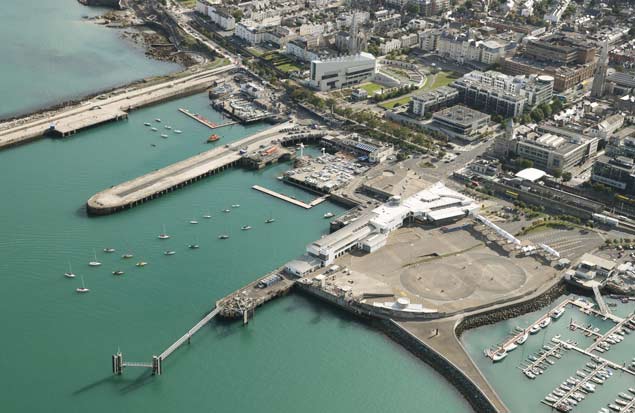 The currently unused Ferry Terminal (right foreground) includes an extensive area originally intended for waiting vehicles. Photo Courtesy Barrow Coakley/Simon Coate
The currently unused Ferry Terminal (right foreground) includes an extensive area originally intended for waiting vehicles. Photo Courtesy Barrow Coakley/Simon Coate
There are many other reasons why the HSS and indeed all ferry services out of Dun Laoghaire ended in 2015. But the unintended consequence is that for nearly five years now, Dun Laoghaire Harbour has been primarily a recreational and residential amenity, which is a long way indeed from that suggestion around 1800 that just one sheltering breakwater should be built. And the ultimate irony is that the lone breakwater in question is now the East Pier which most Dubliners see as being perfect for a stroll, brisk walk or jog – in fact, some reckon that’s what it was designed for.
The suggestion that the Harbour might be quite drastically modified in order to accommodate cruise liners was fiercely resisted, and with the news that even the citizens of Cobh are complaining about the vulgar 24-hour noisiness of the modern cruise liners which berth at their town, we can only imagine the raised levels of indignation in Dun Laoghaire were such a thing to happen in a township where the waterfront is now very much the trendy place to live.
Thus a major sailing event like the Volvo Dun Laoghaire Regatta is important in many ways, and particularly for showing the harbour’s potential as a magic place to have your home. But how can this vitality be given a year-round span? Organisations like the Irish National Sailing School do heroic work in giving the harbour area some vitality on a year round basis, yet as any aerial photos show, the piecemeal development of the waterfront over the years as various uses have arisen, functioned and then died, has left behind much empty space which can surely be better utilised.
 A challenge with Dun Laoghaire is creating a natural interaction between harbour and town, as they are artificially divided by the intervening waterfront roads and railway. Two possibilities are new communities created around the Coal Harbour (left) and on the parking area of the Ferry Terminal. Photo courtesy Barrow Coakley/Simon Coate
A challenge with Dun Laoghaire is creating a natural interaction between harbour and town, as they are artificially divided by the intervening waterfront roads and railway. Two possibilities are new communities created around the Coal Harbour (left) and on the parking area of the Ferry Terminal. Photo courtesy Barrow Coakley/Simon Coate
The basic problem with Dun Laoghaire Harbour is that there is no “Vieux Port”, no ancient corner where you can still find ample waterside evidence of the harbour as it was in its earliest days with ancient inns and boatworks and whatnot. Such places must have existed in old Dunleary, but the roads and the railway have cut them off from the harbour, and they have long since disappeared underneath new developments.
So maybe after we’ve recovered from Volvo Dun Laoghaire Regatta 2019, we might get some fresh thinking on how to keep the harbour quietly yet genuinely alive all year round. For instance, surely an imaginative town planner/architect could think of ways of giving the area around the Coal Harbour more of a sense of community?
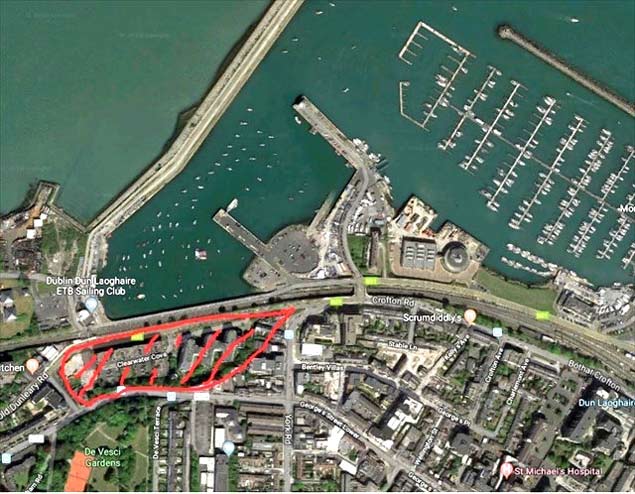 The inner harbour (still known as the Coal Harbour) is all that remains of the ancient coastal community of Dunleary. With some radical thinking, it might be possible to create a proper little maritime community around it
The inner harbour (still known as the Coal Harbour) is all that remains of the ancient coastal community of Dunleary. With some radical thinking, it might be possible to create a proper little maritime community around it
Equally, that vast empty area which used to be the waiting area for the HSS Ferry – even with some space taken up by the Ferry terminal building - is still so large that it is going to take a real leap of vision to find some genuinely valid use for it.
The problem is that Dun Laoghaire is such a rare case. There are very few other comparable ports and seaside towns from which it can learn the way forward. And as it is, many people are perfectly happy with the harbour as it is. But surely it could give a better sense of itself, a real feeling of identity?
That said, the way it is today is largely as a result of unintended consequences, with people who like it as it is fighting their corner with utter determination. So maybe it would be flying in the face of experience to try to plan anything which might have longterm and worthwhile intended consequences. Maybe if everyone just continues to KBO, it’ll be all right in the end, thanks to continuing the long tradition of beneficial unintended consequences.
In the hotly contested Division 2 (A) of Volvo Dun Laoghaire Regatta, Michael and Darren Wright continue their strong form on the Dublin Bay Race track by leading the 20-boat fleet in their Andrieu Half Tonner, Mata. The Class Two ICRA National Champions, who were crowned on the same race track a month ago and Irish Half Ton Cup winners in Kinsale a fortnight ago, are one of five tricked-up Half Tonners from Howth Yacht Club contesting the division.
Sovereign's Cup Class Two winner, Nigel Biggs is second in the customised Half Tonner Checkmate XVIII and third is the Royal Cork modified 1720 sportsboat skippered by Anthony O'Leary.
In what is perhaps a sign of what is to come over the weekend, Howth Yacht Club and Royal Cork Yacht Club entries control the top seven overall after the single race sailed on Thursday.
Fergal Noonan's Corby 25 Impetuous is fifth with a new J97 campaign, The 'Jeneral Lee' (Colin and Kathy Kavanagh) in sixth.



























